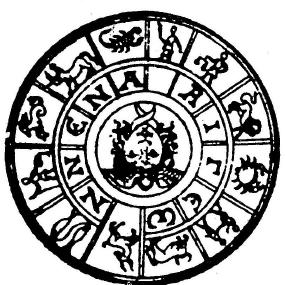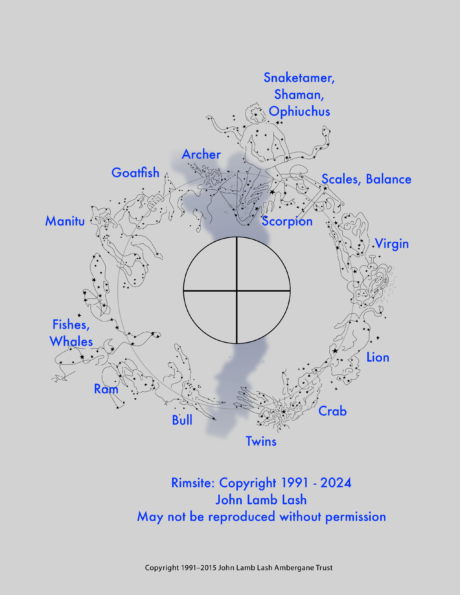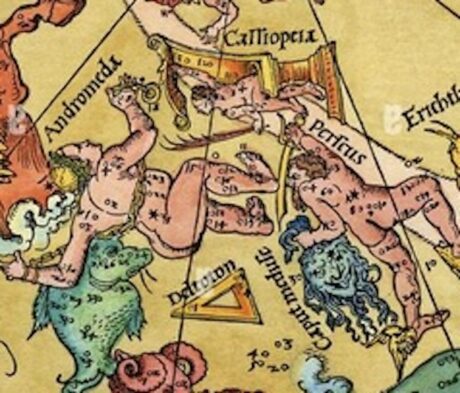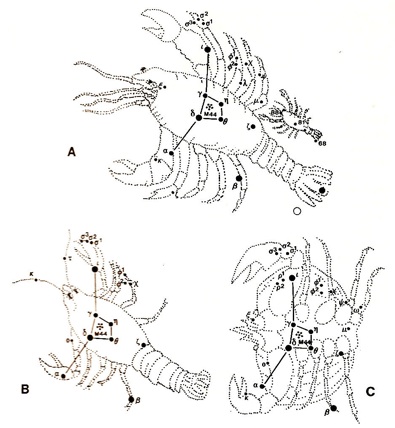Skywatching

Montana Black Footed Ferret by John Ashley
An expansion of the material in this Course can be found on the sister site, Celestics.org, The Art and Method of Forensic Astronomy. Direct inquiries to mail@celestics.org
See also the landing page for the Vocation, Celestics.
ZODIAKOS KYKLOS. Usually translated “belt or circle of animals.” A kyklos is a belt you wear, but it can also mean cycle or circle. You encircle yourself with a belt. Zodiakos derives from the root zoe, “the living, animal life.” Note, by the way, that Zoe appears in Gnostic cosmological texts where she is described as the “flame-born daughter” of Sophia — see below. Somewhere in metahistory.org I commented on the book Dionysos by comparative mythologist and friend of C. G. Jung, Karl Kerenyi, referring to the distinction (correct and essential) he makes between zoe and bios, cited in NIHI:
“Now when Sabaoth (Mother Star) had taken up the place of refuge in return for her metanoia, Pistis the Sophia gave to the Mother Star her daughter Zoe together with great authority so that she might instruct her about all things that exist in the Ogdoad (On the Origin of the World, 104.26–31). Zoe is “life force,” but not just as manifested in biological, creaturely life. Zoe is everlasting, self-renewing life. Immersion in the ecstatic life force produced the psychosomatic regeneration of the Mysteries. Mythologist Karl Kerenyi explains that ZOE is the Dionysian factor, the continuum of “indestructible life,” contrasted to BIOS, the limited biological life-process.
* Ogdoad, the Eighth, is a Mystery term for the celestial realm of starry constellations.
Reading the Sky
In Course 11 Skywatching you are not merely learning how to read the sky, you are connecting through the “circle of animals” to the indestructible life of the Aeons manifested in cycles of animations. This is a powerful and empowering undertaking.

A rare artifact, Roman medallion showing the thirteenth constellation, Ophiuchus, the Snaketamer
At the two o’clock position you see the VIRGIN holding the SCALES, and at the one o’clock position you see the SNAKETAMER. But actually, it is positioned wrongly in the sequence. It should be shown between SCORPION and ARCHER (eleven o’clock position), and the ARCHER points toward the SCORPION not toward the GOATFISH. Despite these errors which indicate a failure of naked-eye observation, the medallion does record the thirteenth constellation which fell into oblivion as the starless astrological signframe came into prominence.
Mythic Images

The shaded area is the thin edge of the Milky Way seen from within where the solar system is embedded.This rendering of the Rimsite from 1991 does not include the two ancillary constellations, the Celestial Anchor which connects the TWINS and the BULL and the CACHE or TREASURE CHEST between the knees of the VIRGIN and the SCALES. The area of the GREAT VOID between the elbow of the ARCHER and the nose of the GOATFISH is also an important region in the real sky zodiac.
The cross at the center of the Rimsite represents the quadrature of the solstice and equinoxes. The arm pointing to the left (as viewed) is the spring equinox or vernal point, VP. Its location marks the current Zodiacal Age. Follow that line and see where it goes. Clearly, we are still living in the Ages of the Fishes or Whales (“Piscean Age”). The VP is at present under the body of the Western Whale.
The Full Circle of the Rimsite
Sign………………………Constellation
Greco-Latin name………”STORY BOOK” NAMEAries………………………….RAM
Taurus……………………….BULL
Gemini………………………TWINS
…………………………………+The Celestial Anchor
Cancer……………………….CRAB
Leo……………………………LION
Virgo…………………………VIRGIN
…………………………………+The Cache, or Treasure Chest
Libra…………………………SCALES or BALANCE
Scorpio……………………..SCORPION
…………………………………SNAKETAMER
Sagittarius…………………ARCHER
…………………………………The Great Void (no distinctive stars)
Capricorn………………….GOATFISH
Aquarius……………………MANITU
Pisces………………………..FISHES or WHALES
Total = 12…………………..Total = 16
Do not be mislead by assuming that a sign converts into a constellation. The above list illustrates the difference in naming the two formats, one starless and the other star-based. To be absolutely clear on the difference, look at this device, a circular ruler, or protractor.

The 360-degree register of twelve equal astrological signs is like a clear plastic protractor laid over the field of irregular constellations on the rim of the ecliptic. There are 16 constellations in the real-sky zodiac, including the Snaketamer, the Great Void, and the two added (+), not shown above. The sign Aries is 1-30 on the register of the transparent, starless signframe. Notice the white line. That sector and all the other 30-degrees division of the protractor compose the structure of the conventional horoscope. Sun, Moon, planets, the rising sign, midheaven, and lunar nodes located in those sectors — for instance, Venus in 10 Scorpio — belong to a format that entirely ignores and excludes the vast panorama of background stars.
Cross-Referenced Terminology
Do not convert received meanings and psychological jargon of the signs into the language of the constellations. Easy to say, but not so easy to do! Many people have acquired the habit of attributing different characteristics to the Sun signs. An Aquarius behaves in a certain way, exhibits certain attitudes and tendencies, may possess specific talents, shortcomings, etc. All that is correct on astrological terms. But behavioral traits are not biographical themes, the material of the constellations. Again, the difference is easy to state but not so easy to work out. Why not?
If you are born, say, on 24-25-26 of February, the Sun is located in the sign Pisces, but also in the face of the Manitu (Watercarrier, “Aquarius”). Does that mean that you are in reality an Aquarius, not a Pisces? No. You are a Pisces with the Sun in the Manitu. You are both at the same time. You learn the characteristics of Pisces from conventional astrology. They still hold true. But “Sun in the Manitu” belongs to a different format that carries themes, capacities, and incentives that differ from the Piscean profile. Nevertheless, certain attributes of the sign Aquarius do bleed over into the elements of the Manitu.
See Celestics.org.
Durer’s Model 1520
Boundaries of the constellation figures are in some cases distinct — Ram<> Fishes — and in other cases hard to determine exactly due to overlap — Fishes<>Manitu, Twins<>Crab, Scorpion<> Snaketamer. The circle running through these figures is the edge of the orbital plane of the earth, the ecliptic. Compare these fine-line Modernist renderings of these figures to the iconic 1520 woodcuts of Albrecht Durer (color enhancement added):

Durer’s figures contrasted to the Rimsite order which runs counter-clockwise. This is because Durer copied the images from a celestial globe where they are pictured in a god’s-eye, seen from outside the solar system. Also, he pictures the Snaketamer standing up and inward from the ecliptic rim (graduated line) toward the center of the sky, while the Rimsite shows him standing outward and above that line.
When I translated zodiakos kyklos I changed the meaning to that above, “circle of animations.” It is most definitely not a circle of animals, obviously not.
Quest for the Zodiac, c. 1999 edited for this unit:
“Zodiac derives from the Greek, usually translated as ‘circle or belt of animals.’ There must be something wrong with this translation, however. It simply does not fit the phenomenon it names. The Star Zodiac is not a naive liquid-crystal display of animal crackers in the sky. A quick scan of the full panorama in Figure Five reveals that few of the creatures are animals. To be exact, there are no more than three animals here. Count them: Ram, Bull and Lion, plus the (mythological hybrid) silly old Goatfish. How could the entire circle have been named after only three components?
“Continuing the inventory, we find four strictly human figures. Two of these belong to the same constellation: the Twins, Castor and Pollux. The others are Ophiuchus, the Snaketamer, a man wrestling with a serpent, and a woman of formidable proportions, known as the Virgin, whose body spans 47 degrees on the Ecliptic. This makes a total of four human figures, counting the Twins as two.
“Next there is a superhuman entity, the Watercarrier. The view-lines indicate the shoulders of a figure with his left arm outstretched and his right arm extended downward, holding an urn or amphora. Significantly, the composite stars identified with the head of the figure are dim and obscure. Some ancient catalogues suggest that the head of the Watercarrier may be comprised of stars in the composite of Pegasus, the Winged Horse, situated just above it. This would not be unusual, for there are numerous cases of stars shared by two different constellations. The form of this entity is human-like, while the mythological lore asserts that the Watercarrier is not a human being but a deity, specifically the Lord of the Southern Ocean, Ea or Enki, in Sumerian-Babylonian lore. The tally is now three animals, four human figures and a single superhuman entity, a deity.
“Then comes the Archer, a hybrid, half-horse, half-man. This is not a human entity pure and simple, neither is it merely a known form of an animal. The Archer is a fantasy-creature, as is the silly old Goatfish, another hybrid consisting of the fore-body of a goat with the tail of a fish or dolphin. Neither of these is an ‘animal’ of the class found in nature as we know it. So, the inventory continues with two weird fantasy creatures.
“Next comes a crustacean, the Crab, an arachnid, the Scorpion, and a couple of Fishes. Some nautical cultures make out the Fishes to be whales, and I have found it helpful to retain this designation. In that case, they would be warm-blooded creatures, classified as mammals and thus close to being ‘animals.’ Crab and Scorpion are, strictly speaking, insects, not quite what we call animals. So the inventory continues: two insects and two fishes.
“Finally, the Zodiac includes one mechanical image, a human-made device, the Balance or Scales.”
Cosmic Animations
This is, let’s admit, quite an odd ‘belt of animals.’ It is difficult to imagine that the ancient Greeks were so poor in their observation of nature that they made no difference between fish, insects, normal animals and bizarre, hybrid animals. Whatever zodiakos kyklos might originally have meant, it had to be something else. I suggest that ‘cycle of animations’ may be closer to the original sense. The Constellations are mythic images, to borrow a term from Joseph Campbell, a comparative mythologist whose work we will consider in Chapter Fourteen. As such, they are eternal entities whose habitat is human imagination, yet they are supercharged with the power of living creatures. They are animated and animating, for they embody ‘meaning’ as a higher form of vitality.

Modernist line rendering of Cassiopeia, mother of Andromeda. This version portrays her bathing in the Milky Way (wavy lines). Compare with the conventional rendering (below) which requires picturing her upside-down, head downward as viewed looking northwards in the northern hemisphere.
This constellation is widely recognized by the distinct shape of its signature stars, forming a splayed W. Observers uninformed in skywatching will notice it without knowing that it represents the mythic figure of Cassiopeia. (It may also be poctured in other ways.) It is situated in the Milky Way between Cepheus and Perseus. It is not an Ecliptic constellation. It is extra-Ecliptic, situated offside the band of the 16 Zodiacal constellations that present the celestial panorama and main data field for Skywatching.
Extra-ecliptic figures also have celestial longitudes (ECL) that track to the ecliptic plane. For instance, the ECL of the star epsilon marking the detail where Cassiopeia touches her right nipple is 56 degrees, equivalent to 26 Taurus in the astrological signs. If you are born on May 4-5-6 of any year, you might be intrigued to know that your natal Sun aligns to that star. The exact local of the Sun on the ecliptic rim is in the legs of the BULL.
This is an unusual case where the astrological sign position, 26 Taurus, “corresponds” to the real-sky mythic figure, BULL. However, while the astrological locales in signs represent personality types, there are no personality types in the system of Celestics. Mythological themes, yes, but not distinct personality types. See Celestics.org for a complete explanation of the difference.

Detail of Durer’s rendering of Cassieopeia sitting on a throne, Andromeda to the left, Perseus to the right.
Durer’s style reminds me of the rather grotesque chunky figures in Zap Comix by R. Crumb. The Triangle is a specious constellation which I restore to a mythic image by attaching it within a lunar disk on the head of the Ram. The Egyptian god Amon is often pictured with such a head-disk sometimes combined with a triangular crown.

Modernist-style line drawing of a woman by Henri Matisse (Holburne Museum), proper way to draw the visualization (“graphics”) of the constellations.
Skywatching Landing Page Audio:
Correction m27: Chapter Fourteen of Quest for the Zodiac, not Not in His Image. Also, I do not require anyone to be steeped in the astronomical myth of Sophia to appreciate and practice Skywatching. I have changed my mind on that point since recording this talk.
Celestial mantique: the art of reading the sky. Mantique comes from the Greek word mantika, a diviner of signs and omens. In the pre-Buddhist Tibetan tradition of BonPo, the dugpa.

Tamang Shaman of BonPo tradition preserved in Nepal today
Phylogenetic memory: the ancestral memory of the diverse races preserved in the memory circuits of the living earth.
Zodiac is not a term for the full-spectrum display of 88 constellations in the celestial sphere. It refers specifically to different formats of the observable heavens. The Chinese, Aztecs, Maya, Hindus, Egptians, Greeks, and more ethnic groups all had their particular methods of formatting the many constellations in the night sky.
Additional skills of the shaman which I omitted to mention in this talk: control of the weather, invocation of elementary forces, contact with Animal Powers and ability to guide others to that contact.Both of which I have demonstrated. If you don’t mind me saying so.
Requirements
What does Course 11 require that you learn? First of all, you are required to observe the sky — but hold on, it may be that you do not have the viewing conditions to do so. What then? Does that exclude you from the Course?
Skywatching is an art that combines visualization with observation. Even if you can’t observe, you can still work on the visualization process. You can learn to picture imaginatively what you will eventually, one day, perceive directly with your eyes. So, there are two lines of study in this Course: direct observation, and visual-imaginative orientation, the exercise of picturing. The material of both studies is the same: the thirteen zodiacal constellations on the path of the sun, the Ecliptic Zodiac. Also called the real-sky zodiac, constellational zodiac, stellar zodiac. To be distinguished from the tropical and sidereal zodiac models, as well as the model of Vedic astrology. The operative tool is the Rimsite.
Additionally, the groundwork or entrance conditions for Skywatching require that you learn:
- How to stand in the sky, forming the body mandala
- How to distinguish the 12 sign sectors from the 13 constellations
- How to read an ephemeris
- How to call the constellations by their correct names
- How to coastline: follow the progress of the earth through the sky in the course of a year
- How to use an archontic sky-viewing device without dependence on it
Graphics

Variations of the CRAB (not Cancer), one of the more difficult of the constellations to picture based on the composite stars and equally difficult to render in graphic form. From Stahl, The New Patterns in the Sky, 1988.
NOTE: Use Constellations of words for research on the lore and picturing of the “cycle of animations.” It contains the full text of the basic research text on sky lore: R. A. Allen, Star Names, 1899.
For an archontic support use the app stellarium.org for orientation but do not become dependent on it exclusively for real-sky observation.
To download this landing page audio: https://nemeta.org/unit/11-101-skywatching-course-landing-page-audio/
11 Skywatching: Course Curriculum
- CELESTIAL MANTIQUE
- CM Timeline to the Target
- CM The Arrow Gains Velocity
- CM Matangi Flips the Script
- 11 Whitelash on the Rise
- 11 CM June 2025
- CM Irish Arising
- § HIGHLIGHTS AND PREVIEWS
- 11 Upstream With the Mothership
- 11 The Perspective of Celestial Timing
- 11 The 2024-25 Saturn Zil
- 11.101 THE ASTRAL INTERFACE
- 11.101 How to Read an Ephemeris
- 11.101 Coastlining
- 11.101 Cosmic Centering
- 11.101 The Body Mandala
- 11.102 THE SKIES OF MEMORY
- 11.102 Eloquent Enigma
- 11.102 Dendera Decoded
- 11.102 Dendera Synopsis
- 103 THE LUNAR CYCLE RITUAL
- Private: 11.103 Naked-Eye Mythology
- 11.103 The Fibonacci Pattern
- 11.103 The Lunation Calendar
- 11.103 Lunation Prompts